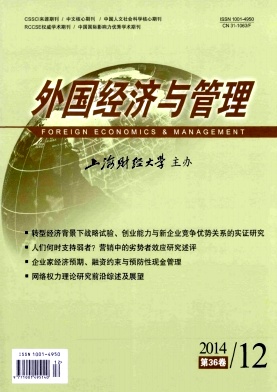企业家经济预期、融资约束与预防性现金管理
外国经济与管理 2014 年 第 36 卷第 12 期, 页码:33 - 46
摘要
参考文献
摘要
本文基于企业预防性现金持有的权衡理论、融资约束理论和代理理论,分析了企业家经济预期、融资约束和企业预防性现金持有三者之间的关系,并使用企业家信心指数作为企业家经济预期的代理变量,实证检验了企业家经济预期对企业预防性现金持有的影响。结果显示,企业预防性现金持有水平明显受到企业家经济预期的影响,两者之间呈现负相关关系;融资约束越强的企业受影响程度越大;东部地区企业受到的影响明显小于中西部地区企业;高公司治理水平的国有控股企业受到的影响明显小于非国有控股企业;低公司治理水平的国有控股企业受到的影响明显大于非国有控股企业。
[1]Almeida H,et al.Corporate financial and investment policies when future financing is not frictionless[J].Journal of Corporate Finance,2011,17(3):675-693.
[2]Ang J and Smedema A.Financial flexibility:Do firms prepare for the recession[J].Journal of Corporate Finance,2011,17(3):774-787.
[3]Bates T,et al.Why do us firms hold so much more cash than they used to?[J].Journal of Finance,2009,64(5):1985-2021.
[4]Bernanke B and Gertler M.Agency costs,net worth and business fluctuations[J].American Economic Review,1989,79(1):14-31.
[5]Brandt L and Li H.Bank discrimination in transition economics:Ideology,information,or incentives?[J].Journal of comparative Economics,2003,31(3):387-413.
[6]Campello M,et al.The real effects of financial constraints:Evidence from a financial crisis[J].Journal of Financial Economics,2010,97(3):470-487.
[7]Cooley T F and Quadrini V.Monetary policy and the financial decisions of firms[J].Economic Theory,2006,27(1):243-270.
[8]Duchin R,et al.Costly external finance,corporate investment and the subprime mortgage credit crisis[J].Journal of Financial Economics,2010,97(3):418-435.
[9]Estrella A and Mishkin F.Predicting U S recessions:Financial variables as leading indicators[J].Review of Economics Statistics,1998,80(1):45-61.
[10]Faulkender M and Wang R.Corporate financial policy and the value of cash[J].Journal of Finance,2006,61(4):1957-1990.
[11]Fazzari S M,et al.Financing constraints and corporate investment[J].Brookings Papers on Economic Activity,1988,(1):141-206.
[12]Franzoni F.Underinvestment vs.overinvestment:Evidence from price reactions to pension contributions[J].Journal of FinancialEconomics,2009,92(3):491-518.
[13]Gertler M and Gilchrist S.Monetary policy,business cycles and the behavior of small manufacturing firms[J].Quarterly Journal of Economics,1994,109(2):309-340.
[14]Keynes J M.The general theory of employment,interest and money[M].Harcourt Brace,London,1936.
[15]Opler T,et al.The determinants and implications of corporate cash holdings[J].Journal of Financial Economics,1999,52(1):3-46.
[16]Perez A.Credit constraints,firms’precautionary investment,and the business cycle[C].EFA 2009Bergen Meetings Paper,Department of Economics and Business,Universitat Pompeu Fabra.Ramon Trias Fargas,Barcelona(Spain),2009:25-27.
[17]Sufi A.Bank lines of credit in corporate finance:an empirical analysis[J].Review Financial Studies,2006,22(3):1057-1088.
[18]Whited T.M and Wu G.Financial constraints risk[J].The Review of Financial Studies,2007,19(2):531-559.
[19]方军雄.所有制、制度环境与信贷资金配置[J].经济研究,2007,(12):82-92.
[20]江龙,刘笑松.经济周期波动与上市公司现金持有行为研究[J].会计研究,2011,(9):40-46.
[21]连玉君,苏治.上市公司现金持有:静态权衡还是动态权衡[J].世界经济,2008,(10):84-96.
[22]刘博研,韩立岩.公司治理、不确定性与流动性管理[J].世界经济,2010,(2):141-159.
[23]刘志远,张西征.投资/现金流敏感性能反映公司融资约束吗?——基于外部融资环境的研究[J].经济管理,2010,32(5):105-112.
[24]罗琦,胡志强.控股股东道德风险与公司现金策略[J].经济研究,2011,(2):125-137.
[25]让·梯诺尔著,王永钦,许海波,佟珺等译.公司金融理论[M].北京:中国人民大学出版社,2007.
[26]申慧慧,于鹏,吴联生.国有股权、环境不确定性与投资效率[J].经济研究,2012,(7):113-125.
[27]辛宇,徐莉萍.公司治理机制与超额现金持有水平[J].管理世界,2006,(5):136-141.
[28]杨兴全,张照南.制度背景、股权性质与公司持有现金价值[J].经济研究,2008,(12):111-122.
[29]余明桂,夏新平,邹振松.管理者过度自信与企业激进负债行为[J].管理世界,2006,(8):104-112.
[30]张西征.中国企业所有权结构对研发投资影响的研究[J].管理学报,2013,10(10):1492-1501.
[31]中国企业家调查系统.企业经营者对宏观形势及企业经营状况的判断、问题和建议——2011·中国企业经营者问卷跟踪调查报告[J].管理世界,2011,(12):55-67.
[32]周伟,谢诗蕾.中国上市公司持有高额现金的原因[J].世界经济,2007,(7):67-74.
[33]祝继高,陆正飞.货币政策、企业成长与现金持有水平变化[J].管理世界,2009,(3):152-158.
[34]庄子罐,崔小勇,龚六堂等.预期与经济波动——预期冲击是驱动中国经济波动的主要力量吗?[J].经济研究,2012,(6):46-59.
[2]Ang J and Smedema A.Financial flexibility:Do firms prepare for the recession[J].Journal of Corporate Finance,2011,17(3):774-787.
[3]Bates T,et al.Why do us firms hold so much more cash than they used to?[J].Journal of Finance,2009,64(5):1985-2021.
[4]Bernanke B and Gertler M.Agency costs,net worth and business fluctuations[J].American Economic Review,1989,79(1):14-31.
[5]Brandt L and Li H.Bank discrimination in transition economics:Ideology,information,or incentives?[J].Journal of comparative Economics,2003,31(3):387-413.
[6]Campello M,et al.The real effects of financial constraints:Evidence from a financial crisis[J].Journal of Financial Economics,2010,97(3):470-487.
[7]Cooley T F and Quadrini V.Monetary policy and the financial decisions of firms[J].Economic Theory,2006,27(1):243-270.
[8]Duchin R,et al.Costly external finance,corporate investment and the subprime mortgage credit crisis[J].Journal of Financial Economics,2010,97(3):418-435.
[9]Estrella A and Mishkin F.Predicting U S recessions:Financial variables as leading indicators[J].Review of Economics Statistics,1998,80(1):45-61.
[10]Faulkender M and Wang R.Corporate financial policy and the value of cash[J].Journal of Finance,2006,61(4):1957-1990.
[11]Fazzari S M,et al.Financing constraints and corporate investment[J].Brookings Papers on Economic Activity,1988,(1):141-206.
[12]Franzoni F.Underinvestment vs.overinvestment:Evidence from price reactions to pension contributions[J].Journal of FinancialEconomics,2009,92(3):491-518.
[13]Gertler M and Gilchrist S.Monetary policy,business cycles and the behavior of small manufacturing firms[J].Quarterly Journal of Economics,1994,109(2):309-340.
[14]Keynes J M.The general theory of employment,interest and money[M].Harcourt Brace,London,1936.
[15]Opler T,et al.The determinants and implications of corporate cash holdings[J].Journal of Financial Economics,1999,52(1):3-46.
[16]Perez A.Credit constraints,firms’precautionary investment,and the business cycle[C].EFA 2009Bergen Meetings Paper,Department of Economics and Business,Universitat Pompeu Fabra.Ramon Trias Fargas,Barcelona(Spain),2009:25-27.
[17]Sufi A.Bank lines of credit in corporate finance:an empirical analysis[J].Review Financial Studies,2006,22(3):1057-1088.
[18]Whited T.M and Wu G.Financial constraints risk[J].The Review of Financial Studies,2007,19(2):531-559.
[19]方军雄.所有制、制度环境与信贷资金配置[J].经济研究,2007,(12):82-92.
[20]江龙,刘笑松.经济周期波动与上市公司现金持有行为研究[J].会计研究,2011,(9):40-46.
[21]连玉君,苏治.上市公司现金持有:静态权衡还是动态权衡[J].世界经济,2008,(10):84-96.
[22]刘博研,韩立岩.公司治理、不确定性与流动性管理[J].世界经济,2010,(2):141-159.
[23]刘志远,张西征.投资/现金流敏感性能反映公司融资约束吗?——基于外部融资环境的研究[J].经济管理,2010,32(5):105-112.
[24]罗琦,胡志强.控股股东道德风险与公司现金策略[J].经济研究,2011,(2):125-137.
[25]让·梯诺尔著,王永钦,许海波,佟珺等译.公司金融理论[M].北京:中国人民大学出版社,2007.
[26]申慧慧,于鹏,吴联生.国有股权、环境不确定性与投资效率[J].经济研究,2012,(7):113-125.
[27]辛宇,徐莉萍.公司治理机制与超额现金持有水平[J].管理世界,2006,(5):136-141.
[28]杨兴全,张照南.制度背景、股权性质与公司持有现金价值[J].经济研究,2008,(12):111-122.
[29]余明桂,夏新平,邹振松.管理者过度自信与企业激进负债行为[J].管理世界,2006,(8):104-112.
[30]张西征.中国企业所有权结构对研发投资影响的研究[J].管理学报,2013,10(10):1492-1501.
[31]中国企业家调查系统.企业经营者对宏观形势及企业经营状况的判断、问题和建议——2011·中国企业经营者问卷跟踪调查报告[J].管理世界,2011,(12):55-67.
[32]周伟,谢诗蕾.中国上市公司持有高额现金的原因[J].世界经济,2007,(7):67-74.
[33]祝继高,陆正飞.货币政策、企业成长与现金持有水平变化[J].管理世界,2009,(3):152-158.
[34]庄子罐,崔小勇,龚六堂等.预期与经济波动——预期冲击是驱动中国经济波动的主要力量吗?[J].经济研究,2012,(6):46-59.
引用本文
张西征. 企业家经济预期、融资约束与预防性现金管理[J]. 外国经济与管理, 2014, 36(12): 33–46.
导出参考文献,格式为:
下一篇:网络权力理论研究前沿综述及展望





 7579
7579  404
404

